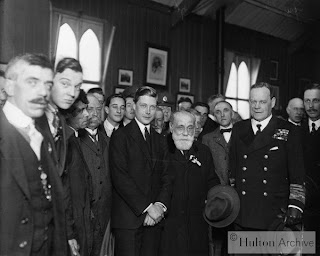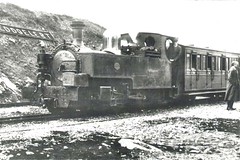James Russell followed his father into the legal profession and became a student at Lincoln's Inn
in November 1862. He was called to the Bar at Lincoln’s Inn in 1867. He practiced at the Chancery Bar and for several years from 1884 was an Examiner at the High Court. An Examiner examined on oath, the witnesses of both parties involved in civil proceedings. The annual law lists for the period show him to have practised from various chambers in Lincoln's Inn, including 23 Old Buildings, as an equity draftsman and conveyancer. A Chambers' address of 14 Old Square is last given in the annual law lists for 1899, indicating a possible date of retirement from the law. Russell was the editor
with Robert Bruce Russell, one of his brothers, of several editions of a
classic of family law "The Rights and Liabilities of Husband And
Wife" originally written by John Fraser Macqueen (1803-1881).
Russell had three elements to his career, law, property development and railways, with law being the corner stone.
The precise details of Russell's career following his call to the bar in 1867 are currently not known, but by November 1876 he was involved with hiring locomotives to the North Wales Narrow Gauge Railways Company. These were the single Fairlies "Snowdon Ranger" and "Moel Tryfan" and the Hunslet engine "Beddgelert". He also financed certain coaches and wagons including ‘three passenger carriages, numbered respectively 6,7 & 8, and the four coal wagons numbered 9.10.11 & 12. From an 1883 accident report, we know that coach number 6 was a Gloucester built Cleminson 6 wheeler and we can surmise that numbers 7 and 8 were of the same design.
The arrangements regarding the ownership of this rolling stock, shed some light on the entrepreneurial aspect of Russell's personality that is also reflected in his property dealings, of which more later.
On the 3rd December 1878, The Moel Tryfan Rolling Stock Company Limited was incorporated "to purchase or otherwise acquire the Locomotives, Engines, Carriages, Wagons, Trucks and Rolling Stock now in use by the N.W.N.G.Railways Co...". The capital was £10,000 and the shareholders included Russell and Ernest E Lake, a solicitor. Lake was a friend of Russell's and later an executor of his estate. The shareholders also included two other barristers in addition to Russell. The directors were Chaloner W Chute a director of the NWNGR and also a shareholder in the MTRSC Ltd, Lake and Russell himself. Like Russell, Chute was a barrister and his family lived on the Vyne Estate in Hampshire. More information on the Vyne Estate at Wikipedia
In an agreement dated 7th December 1878, Russell sold the rolling stock he had hired out, to the MTRSC for £3,630, of which £3,000 was in shares and the balance of £630 cash, but with an option to take shares instead. Russell also assigned to the company a judgement debt for £882 and costs which had been obtained by him against the NWNGR.. With the NWNGR unable to pay the debt, Russell was appointed the Receiver.
The agreement stated that all the items of equipment listed "are marked with the plate of the vendor affixed thereon and are in the possession of the North Wales Narrow Gauge Railways Company and in use by them (except as to the engine "Beddgelert") under a certain lease and agreements for hire dated respectively the Eighteenth day of November 1876, the twenty seventh day of April 1878 and the eighteenth day of October 1878". Thus the agreement is slightly ambiguous on the question of whether the locomotive, Beddgelert was actually on the railway at the time of the agreement. We know that the locomotive had been "sent away" from the builders, the Hunslet Engine Company, from their works at Leeds some four months earlier in July 1878.
From the date of the agreement until 1880 the NWNGR hired their rolling stock from the MTRSC. They then bought them and paid the outstanding hire fee by the issue of £6,000 of Debentures.. On 31st July 1889 the MTRSC filed a company return showing a final redemption of shares that stated "...the supply of rolling stock to a small railway company paid for by installments...was fulfilled" . The company was dissolved in 1894.
While all the business of the MTRSC was going on, Russell was
appointed Receiver of the NWNGR in December 1878 and was chairman from 1879 until his death in
1912.
Russell, as a mortgagee, also had effective control of the Croesor and Portmadoc Railway and was involved with other railway schemes. He became manager of the Manchester and Milford Railway in 1880. This grandiose scheme never got beyond a standard gauge line between Strata Florida and Pencader in Mid Wales, forming part of the Carmarthen and Cardigan line. He remained linked with the Manchester and Milford until resigning in 1899. It was through the M and M that he came into contact with James Weeks Szlumper, although he was also a near neighbour in London.
Szlumper was appointed Engineer to the NWNGR in the summer of 1891, replacing R H Livesey, who had gone to the Finn Valley Railway in County Donegal. Gowrie Aitchison subsequently took over from Szlumper in March 1898.
Both Russell and Szlumper became promoters of a Vale of Rheidol Light Railway scheme. This particular initiative failed to materialise and Russell resigned from the project in 1899, by which time he was 58. The Vale of Rheidol Railway eventually opened in 1902 and is still operating. Szlumper, was knighted in 1894 and became a director of the NWNGR in 1905. He remained active in many railway activities including the Lynton & Barnstaple Railway, until his death in 1926.
 |
James Szlumper (with beard) centre in picture
copyright Hulton Archive |








